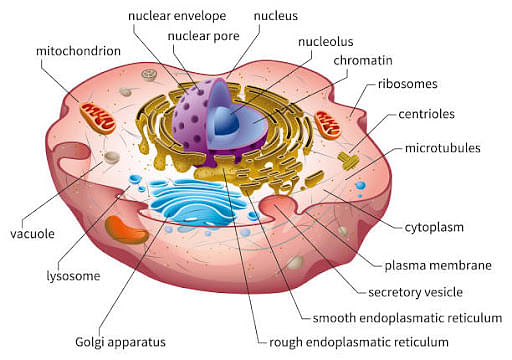Question:
Water soluble pigments found in plant cell vacuoles are -
Water soluble pigments found in plant cell vacuoles are -
Updated On: Apr 20, 2025
- Chlorophylls
- Carotenoids
- Anthocyanine
- Xanthophylls
Hide Solution
Verified By Collegedunia
The Correct Option is C
Solution and Explanation
Option 3: Anthocyanins
Explanation:
- Chlorophylls: These are the pigments responsible for photosynthesis, but they are fat-soluble, not water-soluble. They are primarily found in the chloroplasts of plant cells.
- Carotenoids: These are also fat-soluble pigments that are involved in photosynthesis and give yellow, orange, and red colors to plants. They are not water-soluble.
- Anthocyanins: These are water-soluble pigments that are typically found in the vacuoles of plant cells. They give red, blue, and purple colors to flowers, fruits, and leaves, and are responsible for the colors of many plant parts in acidic conditions.
- Xanthophylls: These are also yellow pigments and belong to the carotenoid group. Like carotenoids, they are fat-soluble, not water-soluble.
Conclusion:
The correct answer is Option 3: Anthocyanins as they are water-soluble pigments found in the vacuoles of plant cells.
Was this answer helpful?
0
0
Top Questions on Cell: the unit of life
- Which organelle is primarily responsible for producing ATP in a cell?
- MHT CET - 2025
- Biology
- Cell: the unit of life
- Which organelle in a eukaryotic cell is primarily responsible for synthesizing proteins destined for secretion?
- MHT CET - 2025
- Biology
- Cell: the unit of life
- Which of the following organisms or organelles contain 70S ribosomes?
- MHT CET - 2025
- Biology
- Cell: the unit of life
- Which term is used for cells performing similar functions and cells collecting intracellular material?
- AIIMS - 2024
- Biology
- Cell: the unit of life
- What is the movement of cytoplasm within a cell called?
- MHT CET - 2024
- Biology
- Cell: the unit of life
View More Questions
Questions Asked in NEET exam
- Two identical point masses P and Q, suspended from two separate massless springs of spring constants \(k_1\) and \(k_2\), respectively, oscillate vertically. If their maximum velocities are the same, the ratio of the amplitude of P to the amplitude of Q is :
- NEET (UG) - 2025
- Waves and Oscillations
A sphere of radius R is cut from a larger solid sphere of radius 2R as shown in the figure. The ratio of the moment of inertia of the smaller sphere to that of the rest part of the sphere about the Y-axis is :

- NEET (UG) - 2025
- Moment Of Inertia
- A microscope has an objective of focal length \(f_o = 2\) cm and an eyepiece of focal length \(f_e = 4\) cm. The tube length of the microscope is \(L = 40\) cm. If the distance of distinct vision of eye is \(D = 25\) cm, the magnification in the microscope is:
- NEET (UG) - 2025
- Optical Instruments
AB is a part of an electrical circuit (see figure). The potential difference \(V_A - V_B\), at the instant when current \(i = 2\) A and is increasing at a rate of 1 amp/second is:

- NEET (UG) - 2025
- Electromagnetic Induction and Inductance
- Twins are born to a family that lives next door to you. The twins are a boy and a girl. Which of the following must be true?
- NEET (UG) - 2025
- Genetics
View More Questions
Concepts Used:
Cell: The Unit of Life
- A cell is derived as the functional and structural unit of life. Every cell is surrounded by a cell membrane that dissects the external and internal environments of the cell. The interior environment of a cell is called the cytoplasm.
- It carries cellular machinery and structural elements. The nucleus is present in the center of the cell, which includes all the hereditary information of an organism. Some of the molecules present in the cell are protein, carbohydrates, starch, and sugar.
Read More: Fundamental Unit of Life: Cell
Parts of Cell:
The different parts of a cell and their functions are as follows:
- Cell Membrane
- Cell Wall
- Nucleus
- Cytoplasm
